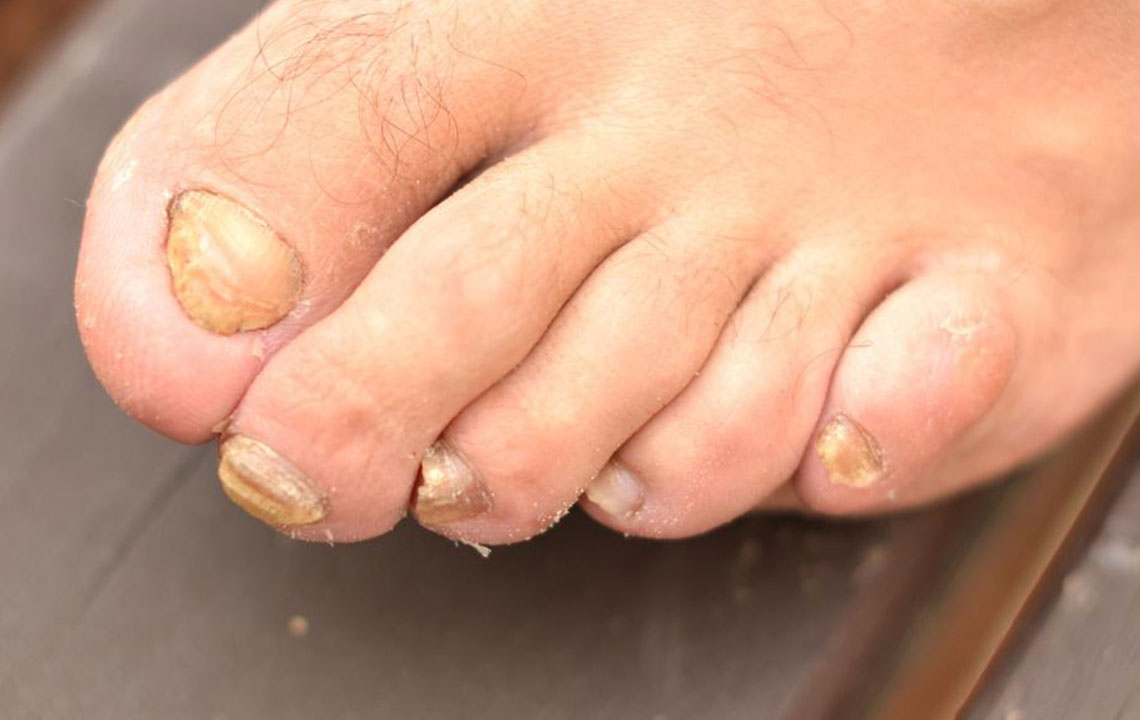Toenail Fungus – Causes, Symptoms and Treatment

Toenail fungus is the bacterial or fungal infection of your toenail or a part of it. When your toes are exposed continuously to a moist or damp environment, it becomes a breeding ground for fungus and bacteria. If you leave this untreated, the infection could spread to your skin, so it is imperative that you get the toenail fungus treated on time.
What causes toenail fungus?
A number of factors cause toenail fungus, here are a few :
- Constant exposure to a damp and moist environment is the most common causal factor of toenail fungus. The type of fungus is usually a dermatophyte.
- If you already are suffering from athlete’s foot, then that can trigger toenail fungus as well.
- Weak blood circulation
- Sometimes, you can contract this infection from others. For example, by wearing the socks or shoes of a person who has toenail fungus can increase your chances of having it too.
- With old age, your blood circulation decreases, which can lead to toenail fungus.
- Excessive sweating
- Walking barefoot
- Contaminated public spaces such as swimming pools and gyms
- Psoriasis
- A weak immune system
- Wearing socks and tight shoes
What are the symptoms of toenail fungus?
- The affected nail thickens. You might find it difficult to trim your nails. The thickness is caused due to the overgrowth of bacteria and fungi.
- Discoloration of the nail is one of the most common symptoms. The nail might turn white, yellow or brown.
- The nail turns brittle, crumbly and will break easily.
- The shape of your nail changes, it can get distorted and ragged.
- Owing to the buildup of debris under your nail, the nail bed becomes a dark color.
- Sometimes, the nail starts to emit a foul odor.
- Hyperkeratosis or scaling under the affected nail.
- Lateral onychomycosis refers to the white or yellow streaks that appear across your nails.
- Proximal onychomycosis is another symptom that involves yellow spots at the bottom of your nail.
- Once the infection reaches its peak, the infected nail might separate and fall off from the nail bed. This is called onycholysis.
Who can get toenail fungus?
Research shows that men are more likely to get toenail fungus, as opposed to women. Also, older people are more affected by it. People who have diabetes are prone to get toenail fungus as well as those with a weak immune system. If you too can identify with such conditions, then you should take appropriate measures to control blood sugar and focus on strengthening your immunity.
If you have the habit of smoking, then you should know that it can contribute to the fungal infection. If you’re a swimmer, make sure you keep yourself clean and dry. Avoid spending too much time in such water. Likewise, make sure you wear shoes that are not too tight. Your feet need to breathe, so don’t keep them covered all the time. Also, keep your feet clean. If it prone to excessive sweating, ensure you wash your feet and dry it thoroughly.
Home remedies for toenail fungus
Toenail fungus can be unpleasant, so the best way to avoid it by adopting healthy and hygienic habits. But unfortunately, if you do contract it, then here are a few ways to treat toenail fungus:
- Coconut oil
Coconut oil is known for its medicinal properties, and it can help treat toenail fungus. It has antifungal and antibacterial qualities, so it can help fight the infection effectively. Apply coconut oil to the infected area three to four times a day, and you will notice the difference. - Baking soda
Baking soda can help prevent the growth of fungus. It can stop the fungal infection from spreading and getting worse. Its alkaline nature doesn’t work in favor of the fungal infection as fungus needs a neutral pH balance to thrive on. - Apple cider vinegar
Applying apple cider vinegar will turn the pH value of the infected area to acidic, which makes it difficult for the fungus to survive. - Tea tree oil
Like coconut oil, even this essential oil has antiseptic and antifungal qualities. You can use it easily by just applying it to the affected area for 15 to 20 minutes. After that gently wipe it away with a cotton pad. If you don’t like tea tree oil, you can substitute it with lavender oil. - Garlic
This ingredient consists of natural elements like allicin and ajoene which have antifungal qualities. Just crush a garlic clove or two and blend it with white vinegar. Apply it on the toenail and cover it with a plain cloth for few hours every day.
Toenail fungus can be embarrassing and even debilitating. Use the above home remedies for quick and painless relief. Remember to consult a dermatologist if the problem continues even after trying these remedies.


